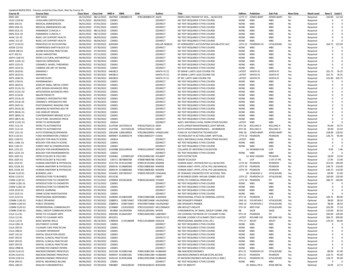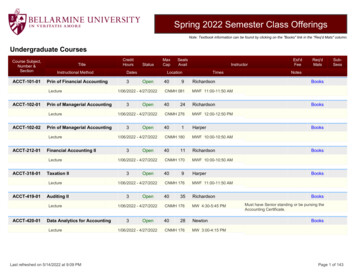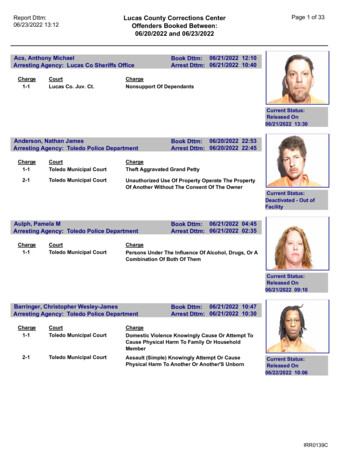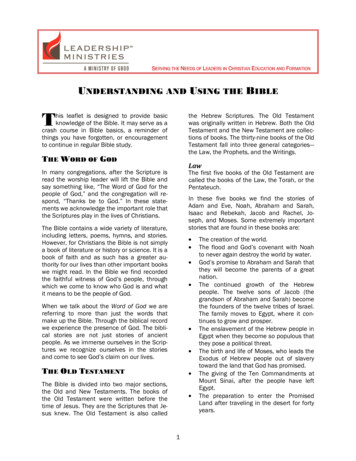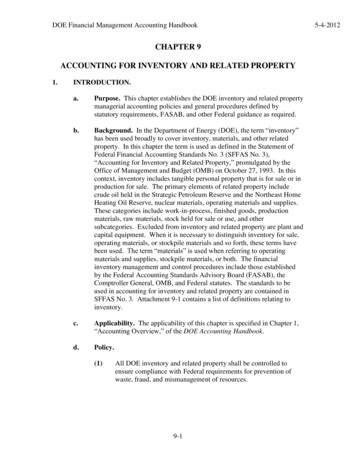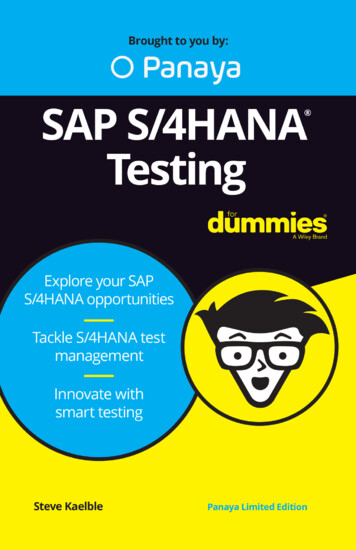
Transcription
These materials are 2022 John Wiley & Sons, Inc. Any dissemination, distribution, or unauthorized use is strictly prohibited.
SAPS/4HANATesting These materials are 2022 John Wiley & Sons, Inc. Any dissemination, distribution, or unauthorized use is strictly prohibited.
SAPS/4HANATesting Panaya Special Editionby Steve KaelbleThese materials are 2022 John Wiley & Sons, Inc. Any dissemination, distribution, or unauthorized use is strictly prohibited.
SAP S/4HANA Testing For Dummies , Panaya Special EditionPublished by:John Wiley & Sons, Inc.111 River St.Hoboken, NJ 07030-5774www.wiley.comCopyright 2022 by John Wiley & Sons, Inc., Hoboken, New JerseyNo part of this publication may be reproduced, stored in a retrieval system or transmitted in anyform or by any means, electronic, mechanical, photocopying, recording, scanning or otherwise,except as permitted under Sections 107 or 108 of the 1976 United States Copyright Act, withoutthe prior written permission of the Publisher. Requests to the Publisher for permission should beaddressed to the Permissions Department, John Wiley & Sons, Inc., 111 River Street, Hoboken, NJ07030, (201) 748-6011, fax (201) 748-6008, or online at http://www.wiley.com/go/permissions.Trademarks: Wiley, For Dummies, the Dummies Man logo, The Dummies Way, Dummies.com,Making Everything Easier, and related trade dress are trademarks or registered trademarks of JohnWiley & Sons, Inc. and/or its affiliates in the United States and other countries, and may not be usedwithout written permission. All other trademarks are the property of their respective owners.John Wiley & Sons, Inc., is not associated with any product or vendor mentioned in this book.LIMIT OF LIABILITY/DISCLAIMER OF WARRANTY: WHILE THE PUBLISHER AND AUTHORS HAVEUSED THEIR BEST EFFORTS IN PREPARING THIS WORK, THEY MAKE NO REPRESENTATIONSOR WARRANTIES WITH RESPECT TO THE ACCURACY OR COMPLETENESS OF THE CONTENTS OFTHIS WORK AND SPECIFICALLY DISCLAIM ALL WARRANTIES, INCLUDING WITHOUT LIMITATIONANY IMPLIED WARRANTIES OF MERCHANTABILITY OR FITNESS FOR A PARTICULAR PURPOSE.NO WARRANTY MAY BE CREATED OR EXTENDED BY SALES REPRESENTATIVES, WRITTENSALES MATERIALS OR PROMOTIONAL STATEMENTS FOR THIS WORK. THE FACT THAT ANORGANIZATION, WEBSITE, OR PRODUCT IS REFERRED TO IN THIS WORK AS A CITATION AND/OR POTENTIAL SOURCE OF FURTHER INFORMATION DOES NOT MEAN THAT THE PUBLISHERAND AUTHORS ENDORSE THE INFORMATION OR SERVICES THE ORGANIZATION, WEBSITE, ORPRODUCT MAY PROVIDE OR RECOMMENDATIONS IT MAY MAKE. THIS WORK IS SOLD WITHTHE UNDERSTANDING THAT THE PUBLISHER IS NOT ENGAGED IN RENDERING PROFESSIONALSERVICES. THE ADVICE AND STRATEGIES CONTAINED HEREIN MAY NOT BE SUITABLE FORYOUR SITUATION. YOU SHOULD CONSULT WITH A SPECIALIST WHERE APPROPRIATE. FURTHER,READERS SHOULD BE AWARE THAT WEBSITES LISTED IN THIS WORK MAY HAVE CHANGEDOR DISAPPEARED BETWEEN WHEN THIS WORK WAS WRITTEN AND WHEN IT IS READ.NEITHER THE PUBLISHER NOR AUTHORS SHALL BE LIABLE FOR ANY LOSS OF PROFIT OR ANYOTHER COMMERCIAL DAMAGES, INCLUDING BUT NOT LIMITED TO SPECIAL, INCIDENTAL,CONSEQUENTIAL, OR OTHER DAMAGES.For general information on our other products and services, or how to create a custom ForDummies book for your business or organization, please contact our Business DevelopmentDepartment in the U.S. at 877-409-4177, contact info@dummies.biz, or visit www.wiley.com/go/custompub. For information about licensing the For Dummies brand for products or services,contact BrandedRights&Licenses@Wiley.com.ISBN 978-1-119-83018-4 (pbk); ISBN 978-1-119-83019-1 (ebk)These materials are 2022 John Wiley & Sons, Inc. Any dissemination, distribution, or unauthorized use is strictly prohibited.
IntroductionYour enterprise resource planning (ERP) system is absolutely essential to the success of your business. Dependingon the details of your implementation, practically all keyoperations are plugged into this central collection of software —from financials and accounting, to human resources, to supplychain management, to manufacturing, to business intelligence, tocustomer resource management. Any aspect that doesn’t work atits peak can throw your business into chaos.That’s why testing is such an important part of maintaining yourERP system. You’re always upgrading, making changes, adaptingfor new business processes, keeping up with evolving needs. Andevery change you make is an opportunity for something to fail.Your testing program is your line of defense against that failure.You may be doing unit testing, focused on individual transactionsor function modules. Your team may be focused on system integration testing, linking your ERP with other applications. Perhaps you’re in charge of regression testing, ensuring that changedoesn’t unintentionally affect functionality in the wrong way.You may be focused on user acceptance testing, getting validationfrom business users.And you may soon be called upon to do some of the most important testing ever, as your organization moves its ERP into the newworld of SAP S/4HANA. It’s the latest and greatest product froma leader in ERP, a revolutionary new system, and moving to thisnew incarnation means lots of change and, yes, testing.Is your testing program ready for this challenge? Are you weddedto traditional methods that are marked by tedious and sometimesrepetitive work? Are you counting on automation, which can certainly help but is really not the be all and end all solution? Arethere ways to improve upon your system, before you embark onan S/4HANA journey? Are you open to new and innovative solutions for bringing intelligence to testing?Introduction1These materials are 2022 John Wiley & Sons, Inc. Any dissemination, distribution, or unauthorized use is strictly prohibited.
About the BookSAP S/4HANA Testing For Dummies, Panaya Special Edition, is yourguide for ensuring your testing program is in tip-top shape heading into the S/4HANA implementation experience. It’s packed withimportant background on ERP systems, and why testing relatedto these systems must focus heavily on business processes. Itexplores how essential it is to get business users involved in yourtesting program, how their knowledge of business processes isabsolutely critical, how best to get them connected to your testingwork, and how engaging them in the testing helps build buy-infor change.Read on for background about S/4HANA, why it’s great, andwhat’s so different about the way it functions. The book includesdetails of various approaches for an S/4HANA implementation —greenfield, brownfield, landscape transformation — as well asyour options for implementing on-premise or in the cloud. You’llalso find details on the best practices that SAP offers for ensuringsuccess.In the pages ahead, you’ll find a lot of discussion of useracceptance testing, why it’s crucial, and how to make it workmuch more efficiently. There’s a whole chapter on automation —which parts of testing are ripe for automation and which are not.And there’s plenty of actionable advice on how to move forward.That includes evolving toward a next-generation testing platform before you make the S/4HANA journey, and also thoughtson making a greenfield implementation a roaring success.Foolish AssumptionsIn writing this book, we’ve taken the liberty of assuming a fewthings about you, the reader:»» You’re heavily involved in SAP-related work, as a project orprogram manager, perhaps, or maybe a solution architect orfunctional analyst, or a test/QA manager.2SAP S/4HANA Testing For Dummies, Panaya Special EditionThese materials are 2022 John Wiley & Sons, Inc. Any dissemination, distribution, or unauthorized use is strictly prohibited.
»» Whatever your title, your work has a lot to do with testingand test planning, whether it’s business process testing, useracceptance testing, regression testing, or something else.»» You know there is a better way to manage and execute yourtesting program, and are open to great new ideas.Icons Used in This BookIn the margins of the book are some helpful icons that will guideyour journey. They highlight paragraphs that you won’t wantto miss:We won’t be offended if you don’t soak up every word in thisbook, but if you’re not reading cover-to-cover, be sure to at leastpay attention to this point.The hope is to send you off with some actionable insights and valuable steps to take. This is one of them.Your aim is to simplify your processes as much as possible, but ifyou like technical details, read here.Testing is intended to keep things from going awry; this icon callsspecial attention to something that could cause trouble if you’renot careful.Beyond the BookThis book is intended to be a quick read, with insights and helpful tips. And it’s arranged in a way that can be consumed however works best for you — front-to-back, a little here and a littlethere, or whatever.Introduction3These materials are 2022 John Wiley & Sons, Inc. Any dissemination, distribution, or unauthorized use is strictly prohibited.
It’s likely that you’ll come away informed, but potentially hungryfor even more information. Here are some resources to consult:»» www.sap.com/index.html: Here’s a wealth of furtherinformation about the ERP and related products from SAP,including full product details, resources, and supportconnections.»» panaya.com: Product information, resources, and supportfrom a leader in change intelligence and testing successfor ERP.»» success.panaya.com: The Panaya Success Center is full ofresources for getting the most out of Panaya solutions fortesting and change intelligence.4SAP S/4HANA Testing For Dummies, Panaya Special EditionThese materials are 2022 John Wiley & Sons, Inc. Any dissemination, distribution, or unauthorized use is strictly prohibited.
IN THIS CHAPTER»» Understanding the role of the ERP»» Moving to SAP S/4HANA»» Outlining the implementation options»» Ensuring proper testingChapter1Embracing S/4HANATestingYour enterprise resource planning system is at the heart ofall that your business does. Any issues with the way it functions can grind vital parts of your operation, or your entireoperation, to a halt.This chapter explores the importance of the ERP and specificallyfocuses on the products of SAP. It discusses S/4HANA, the latest and greatest version of SAP’s offerings, and the challenges ofimplementing this new incarnation. Read on to learn more aboutwhy you’ll want to make the move to S/4HANA, what your implementation choices are, some details about how those variousimplementations take shape, and the vital role that testing playsno matter which kind of implementation you choose.Operating the EnterpriseImagining a business world without ERP is rather difficult. Enterprise resource planning software is like the central nervous system of a big organization; the backbone that makes it functioneffectively.CHAPTER 1 Embracing S/4HANA Testing5These materials are 2022 John Wiley & Sons, Inc. Any dissemination, distribution, or unauthorized use is strictly prohibited.
Consider all of the various core processes that your organizationneeds: finance, human resources, procurement, the supply chain,manufacturing, and services, among others. They’re all differentprocesses, but they’re incredibly interdependent, so ERP integrates them into a single system and database.Things weren’t always this way, of course. Businesses didn’t usecomputerized processes at all until the 1960s, and as computing became more powerful and available, companies used it forprocessing sales orders and making manufacturing requirementsplanning more sophisticated. By the 1980s, manufacturers werepulling other disciplines into their manufacturing requirementsplanning, including accounting, sales, purchasing, and inventory.In the 1990s, ERP emerged to bring even more business processesand workflows into one place. Internet advances made it all themore powerful, transformative, and reasonably easy to use. Nowit’s a way of life for successful businesses.But because ERP is a way of life, it’s now nearly impossible tolive without. ERP systems are incredibly complex, with multipledependencies and related business processes. They take a lot ofeffort to build and maintain. Any glitches can disrupt businesscontinuity, and disruptions to business continuity are not welcome, to say the least.Indeed, even a small glitch can carry a big cost. Every year, businesses lose millions of dollars when their business applicationsfail. And there are so many interdependencies across an ERP system, a hiccup in one area can lead to serious heartburn in another.That’s why testing is essential and continuously needed. That’sparticularly true for upgrades or business transformation projectsthat lead to changes or reengineering of business processes.That brings us to the subject of SAP. The German software company, originally known as System Analysis Program Developmentwhen it launched in the early 1970s, was one of the pioneers in thebusiness of ERP and is a perennial market leader.The company’s ERP product integrates all of an enterprise’s corefunctions through various modules, such as (not exhaustive):6SAP S/4HANA Testing For Dummies, Panaya Special EditionThese materials are 2022 John Wiley & Sons, Inc. Any dissemination, distribution, or unauthorized use is strictly prohibited.
»» SAP FICO: This module covers financial and cost accounting.»» SAP HCM: As you might guess from the title, this handles thehuman capital management.»» SAP MM: Here’s a module that keeps a close eye onmaterials management.»» SAP SD: The acronym is a clue that this module brings salesand distribution into the picture.»» SAP SCM: Here’s what ensures effective supply chainmanagement.SAP’s ERP plays nicely with such SAP products as SuccessFactors,Ariba, Concur, and Hybris, any of which can be used to complement, replace, or modernize existing SAP modules. Many customers prefer such non-SAP applications as Salesforce and Workday,which can be integrated with SAP but must be tested from theend-to-end perspective.Needless to say, the functionality is powerful. And it takes asolid understanding of all of the features and functions and bestpractices to be successful in implementing and operating thesystem — not to mention testing it. Testing is not just a step inthe project, in fact, but should be considered as a project in andof itself.As mentioned above, testing is always a vital step in softwareevolution, and particularly critical when that evolution is morelike revolution. That brings us to the subject of S/4HANA, the latest incarnation of SAP’s ERP platform. Moving from SAP ECC orany other ERP to S/4HANA is not merely an update, but a transformation that requires plenty of time, planning, commitment,and of course, testing.Moving to S/4HANACompanies have been operating their enterprises with SAP ERPsoftware since the 1990s. They’ve been using such product iterations as SAP R/3 and SAP ECC, and versions ranging up to SAPECC 6.0. It was around 2015 that the very latest concept emerged,known as SAP for HANA, aka S/4HANA.CHAPTER 1 Embracing S/4HANA Testing7These materials are 2022 John Wiley & Sons, Inc. Any dissemination, distribution, or unauthorized use is strictly prohibited.
The first thing that many people ask is, what’s with that name?The answer is that S/4HANA is optimized for SAP’s columnoriented, in-memory database called SAP HANA, with the HANApart short for High-Performance Analytic Appliance.This is a significant shift in numerous ways that tech-orientedpeople will understand, but the bottom line for everyone else inthe organization is simply much better performance. In-memorymeans that data is stored in the main memory for faster accessand processing. Column-oriented means that data in each specificcolumn is stored in the same place, which is different from theway things work in row-oriented databases. Different, and again,higher performance.It’s a revolutionary enough change that SAP was inspired toinclude it in the name of the product, S/4HANA. But that’s farfrom the only revolution that comes along with a migration toS/4HANA.The change that will be most noticeable to the average user is theinterface. If you implement S/4HANA Cloud multi-tenant edition,you’ll be using only web applications mainly based on SAP Fiori.Your users will appreciate Fiori apps that modernize processesand upgrade the user experience. If you go with S/4 HANA Cloudsingle-tenant edition or S/4HANA on-premise for your implementation, you can still work with the regular interface, but tapinto a launchpad using Fiori.SAP Fiori is web-based and uses the SAPUI5 development toolkit,based on HTML5. Developers can use SAPUI5 to create their owncustomized, Fiori-based applications.The Fiori launchpad brings great results in terms of usability anda true mobile experience. It tends to replace legacy SAP portalthat had been implemented by many SAP customers in the last15 years and has been the web-based portal supporting some SAPprocesses.Add it all up and you have improved technical performance,coupled with a more appealing and potentially easier to use userinterface. What’s not to like? Of course, companies will want tomigrate to S/4HANA (and plenty have done so already).8SAP S/4HANA Testing For Dummies, Panaya Special EditionThese materials are 2022 John Wiley & Sons, Inc. Any dissemination, distribution, or unauthorized use is strictly prohibited.
It’s not exactly a walk in the park, though. This is no simpleupgrade, but a true transformation. The whole architecturechanges when you move to S/4HANA, along with that nifty newuser interface. Beyond that, the way you work with some transactions has changed, which means rethinking some businessprocesses.That means lots and lots of planning and preparation, and a lotof testing. As we said, some companies have taken the plunge,others are waiting, feeling like there’s still time to take it slow.They’re content with the knowledge that the current version isstill getting the job done just fine, so why rock the boat?Time is ticking, though. SAP will stop supporting ECC in 2027,and those that want to stick with ECC after that point will pay apremium on support, up to 32 percent. Given that, a lot of companies view 2027 as the real deadline.The day will inevitably come, however, when SAP support for earlier versions will end for good. So you can’t really avoid thinkingabout migrating to S/4HANA.Exploring the OptionsAs it turns out, on the topic of migrating to S/4HANA, there’s a lotof thinking to do. That’s because there are multiple approachesthat your organization might choose to take, and there is no single right or wrong answer.Your path forward depends upon a lot of variables that are veryspecific to your current situation. The most common implementation options include brownfield (migration), greenfield (newimplementation), and landscape transformation. The implementation will also be very closely linked to the deployment type youchoose — on-premise, multi-tenant cloud, or single-tenant cloud.Which one of these paths is the right approach? To answer that,your organization needs to do some extensive analysis, evaluating the situation from both technical and functional perspectives.You need to consider your existing system landscape and businessfunction, and give a lot of thought to user readiness.CHAPTER 1 Embracing S/4HANA Testing9These materials are 2022 John Wiley & Sons, Inc. Any dissemination, distribution, or unauthorized use is strictly prohibited.
Even more important, you need to be mindful of the big pictureof digital transformation. You need to make the right choice fornow, but also for what you want your organization to be in theyears ahead.Opting for brownfieldThe brownfield approach assumes that you already are an SAP ERPuser. You have a system in place, and you’re ready to make themove to S/4HANA.Brownfield essentially means that you’re bringing some of theold to blend in with the new. If your organization is a longtimeadherent to the old functionality, it can be comforting to takesome of that functionality with you into the new world, just asyou likely bring at least some of your old furniture with you whenyou move into a new home.In this case, it’s not furniture but legacy code and data, too. Whenyou opt for brownfield, you take a look at what functionalityyou’re using and what you feel confident you’ll continue to need.You’re taking custom code, and you’re moving data.SAP recommends this kind of system conversion for existing customers who want the new capabilities but fear they’ll lose whatthey’ve invested in their current system. If you want to preservebusiness processes as much as possible, this is your best bet for that.Brownfield system conversion is definitely a sensible way to go,unless you decide that the legacy code you’re converting is a bittoo ancient to make the move. Remember, SAP has been in theERP business for a long time, and if you’ve been using it for years,that custom code might be too tied to yesteryear’s approaches,increasing system complexity and slowing down your changes.And if it is suitable to bring from the old world to the new, it stillwill require significant work to successfully adapt. You may needto move some business processes to new Fiori apps, but even ifyou stick with the SAP user interface for some business processesin a brownfield implementation, there may be reengineeringrequired. And reengineered business processes all require testing.According to SAP, some 50 to 60 percent of organizations installing S/4HANA are doing so through system conversion. The upsideis that there are tools and guidelines for conversion — an exampleis Panaya’s S/4HANA System Conversion solution.10SAP S/4HANA Testing For Dummies, Panaya Special EditionThese materials are 2022 John Wiley & Sons, Inc. Any dissemination, distribution, or unauthorized use is strictly prohibited.
Transforming the landscapeAnother concept in S/4HANA adoption involves migrating variousSAP ERP systems, or even non-SAP systems, into a new globalS/4HANA system. Landscape transformation requires the preparation of a new master system, followed by the transfer of data intothat system from the older systems across the landscape.That master system could be a brand-new S/4HANA system, or anexisting system that’s optimized for its new role. Either way, processes are reimagined and benefit from various innovations. Andit achieves the benefits of moving the data into a HANA database.One more benefit is that it can be a bit more gradual. You can firstchoose to move processes that offer the best and fastest return oninvestment. Getting early wins is always a great way to managechange and achieve the most enthusiastic buy-in.Choosing a greenfield approachYour organization may choose to essentially start from scratchwith an S/4HANA implementation. This is the only choice, ofcourse, if you’re new to SAP and are not making the move froman earlier version. But there are also reasons to go down this patheven if you’re already on an SAP ERP system.Greenfield means your canvas is blank as you implementS/4HANA. You’re not bringing along legacy code and the businessoperations that code supports, but rather getting a fresh start.You’re getting all-new furniture in your all-new house. It’s anopportunity to redefine and simplify business processes, and atthe same time, take full advantage of S/4HANA capabilities.Greenfield implementation of S/4 HANA can be deployed via thecloud or traditional on-premises edition. Although SAP offers afull cloud solution, going full cloud may be disruptive for somecustomers, so SAP offers an alternative single-tenant edition thatbrings more flexibility for SAP updates, UI options, and systemconfiguration.But why go greenfield if there’s something in your existinginstallation that might be salvageable? Well, for one thing, a legacy business operation moving over in a brownfield implementation might not make the transition smoothly. Old functionalitypotentially might not play well with the new functionality, andthat’s one problem you won’t have with greenfield.CHAPTER 1 Embracing S/4HANA Testing11These materials are 2022 John Wiley & Sons, Inc. Any dissemination, distribution, or unauthorized use is strictly prohibited.
What’s more, because you’ve decided from the get-go that you’releaving the old stuff behind, you don’t have to go to all the troubleof deciding what you’re going to bring along, and making all thepreparations for the move. It’s that much simpler.No, that doesn’t mean it’s simple, by any means! A new greenfieldimplementation of S/4HANA is time-consuming, potentially tiresome, and involves a ton of change management.You’re moving on without some of your well-worn functionality, and you may also be leaving data behind. A fresh start meanslots of new design, reworking of business processes, and lots ofattention needed from business users for new process definition,training, user acceptance training, and the like.Converting or transformingIf your choice is system conversion or landscape transformation,a smooth change should follow the proper sequence. Your projectwill have a preparation phase, followed by realization.Here are the basic elements of the preparation phase:»» Checking into the system requirements: You’re analyzingthe existing system so that you can find the best way toexecute the migration.»» Conversion pre-check: It’s important to check any add-onsor business functions active in the current system to becertain they can technically be converted into S/4HANA. SAPoffers a Simplification Item Check that runs you through themandatory steps before converting your system.»» Custom code migration: You’ve potentially spent yearscreating custom SAP code in your existing system, so nowyou need to check it to be sure it’s compatible with S/4HANA.That’s the preparation. Now here’s what’s entailed in realizationif you’re going down the route of system conversion or landscapetransformation:»» System installation: This is the big to-do: actually gettingdown to the business of converting to S/4HANA. Amongmany other things, you’re migrating databases and converting data.12SAP S/4HANA Testing For Dummies, Panaya Special EditionThese materials are 2022 John Wiley & Sons, Inc. Any dissemination, distribution, or unauthorized use is strictly prohibited.
»» Follow-on activities: With the conversion taken care of, youhave to migrate all the custom settings and take care ofother matters. This includes a data consistency check(especially for financial data). All relevant components fromFinancial Accounting and Controlling are collected into onedata pool, so you need to perform reconciliation and mergeit all correctly into the Universal Journal. And after you’vedone all the necessary customization, iteration testing will besure everything is running correctly.Understanding the greenfieldmethodologyA methodology called SAP Activate provides the details for all thesteps involved in the greenfield approach, and it’s supplementedby SAP Best Practices (available in the Panaya’s testing solution)that ease implementation and testing. Here are the basics of SAPActivate, in order:»» Discover: This is when you take a look at the value of yourbusiness and develop a roadmap for projectimplementation.»» Prepare: This is the real beginning of the project work.You’re finalizing the plans that you began working on in theprevious step and getting the team ready to roll. It goeswithout saying that you need the right people on the team.»» Explore: There are all kinds of business solutions that arepart of S/4HANA, especially when you’re choosing a newimplementation. You’ll go through the scope evaluationprocess, and you can choose a fit/gap analysis instead oftraditional blueprint requirements to make the implementation faster and more efficient.»» Realize: Business requirements were defined previouslyalong the path, and now comes the realization process ofthose business requirements. You’re taking a look at suchthings as system configuration settings, integration scenarios, and data migration.»» Deploy: Here’s where you set up the production environ-ment. When the time is right, you’ll launch cutover activitiesand move business operations to the new system.CHAPTER 1 Embracing S/4HANA Testing13These materials are 2022 John Wiley & Sons, Inc. Any dissemination, distribution, or unauthorized use is strictly prohibited.
Choosing on-premise or cloudDecisions, decisions, decisions. Whether to go greenfield, brownfield, or landscape transformation is just the beginning of theoptions and considerations and choices.Another biggie is where your S/4HANA implementation is goingto live. There’s an on-premise version that many organizationschoose. It’s especially fully featured and, if you’re migrating froman earlier SAP business suite, can be an exceptional choice.There’s also a pure cloud and private cloud edition of S/4HANA.It’s ideal for many of the same reasons you might choose anyother kind of cloud implementation, from accessibility to morestreamlined adoption (comparatively speaking, anyway), plussomewhat more simplified maintenance considerations.Your decision will impact many aspects of how your project progresses. Most significantly, a move to S/4HANA Cloud edition canonly be greenfield — migration is not an option. In any case, nomatter which way you go, significant testing will be part of yourfuture.Insisting on TestingWith regard to your ERP system, what kinds of changes need to betested? That may be an easier question to answer than most. Let’sjust say, nearly everything!Any kind of transformational change to your ERP always must betested before moving into production. That includes everythingfrom significant implementations, upgrades, and expansions, tomore minor updates and fixes.The truth is, if an ERP implementation project fails, one of the bigreasons is improper test pl
Introduction 1 These materials are 2022 John Wiley & Sons, Inc. Any dissemination, distribution, or unauthorized use is strictly prohibited. Introduction


